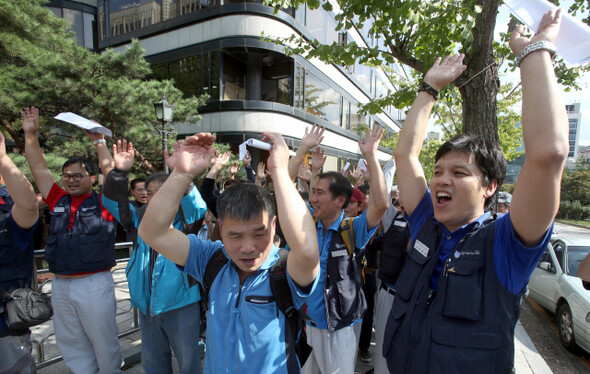hankyoreh
Links to other country sites 다른 나라 사이트 링크
[Reporter’s notebook] Court rules in favor of Kia in-house subcontractor workers

By Park Seung-heon, staff reporter
A court ruled on Sept. 25 that 468 in-house subcontractor workers at Kia Motors had been illegally dispatched.
The ruling comes just a week after Seoul Central District Court ruled in favor of Hyundai Motor in-house subcontractor workers who had filed suit demanding recognition as regular workers according to the law.
But with Hyundai Motor filing an appeal of that ruling on Sept. 24, and Kia showing signs of following suit, the in-house subcontracting workers may be in for another exhausting legal battle against the automakers, which are so far refusing to back down.
That uncompromising attitude has also carried into wage negotiations and collective bargaining. GM Korea and Ssangyong Motor both concluded their talks early on after a Supreme Court ruling last year by adding bonuses into regular wages. But Hyundai and Kia have consistently responded to demands to do the same by insisting on “waiting until the court ruling” for Hyundai. A partial strike by the labor union was met with “concerns” about a setback in production.
Blaming the union for any and all problems and insisting on “sticking to their guns” over compromising out of concern for short-term losses are both longstanding characteristics of labor-management relations at Hyundai and Kia. Critics have lambasted Hyundai and Kia for their double standard: insisting on “respecting the court’s judgment” on the ordinary wage issue, then trying to encourage in-house subcontracting workers to drop their suit before the ruling by attempting to hire them on through “one-on-one agreements.”
Both companies have worked since the early 2000s to grow stronger through quality management. Worldwide sales have boomed as a result, rising from 2.35 million cars in 2002 to 7.56 million last year. After betting big and winning with a bid to acquire land from the Korean Electric Power Corporation, they confidently talked about “a decision with a hundred years‘ foresight and an opportunity for a second leap forward.”
But their attitude and approach on labor-management relations remain stuck in the distant past.
Even many at the companies have said there is fairly strong support for changing their approach to workers. Their concern is that speaking out against the company’s official line could come across as “insubordination,” and that the top-down decision-making system prevents other voices from being heard openly.
Both companies have a definite legal right to appeal the in-house subcontractor ruling. But both also have a question to consider before making that decision: will new cars and a new building alone be enough to make the “second leap forward”?
“They only really stand to lose from dragging out a legal battle that could make it look like they‘re just buying time with the in-house subcontractor workers,” said Park Tae-ju, a professor at the Employment and Labor Training Institute.
“In the long term, they would be better off using this time as a jumping off point for change: considering ways of establishing job security and internal flexibility [including production movements] and finding approaches to increase productivity,” Park advised.
Please direct questions or comments to [english@hani.co.kr]

Editorial・opinion
![[Column] Season 2 of special prosecutor probe may be coming to Korea soon [Column] Season 2 of special prosecutor probe may be coming to Korea soon](https://flexible.img.hani.co.kr/flexible/normal/500/300/imgdb/original/2024/0426/3317141030699447.jpg) [Column] Season 2 of special prosecutor probe may be coming to Korea soon
[Column] Season 2 of special prosecutor probe may be coming to Korea soon![[Column] Park Geun-hye déjà vu in Yoon Suk-yeol [Column] Park Geun-hye déjà vu in Yoon Suk-yeol](https://flexible.img.hani.co.kr/flexible/normal/500/300/imgdb/original/2024/0424/651713945113788.jpg) [Column] Park Geun-hye déjà vu in Yoon Suk-yeol
[Column] Park Geun-hye déjà vu in Yoon Suk-yeol- [Editorial] New weight of N. Korea’s nuclear threats makes dialogue all the more urgent
- [Guest essay] The real reason Korea’s new right wants to dub Rhee a founding father
- [Column] ‘Choson’: Is it time we start referring to N. Korea in its own terms?
- [Editorial] Japan’s rewriting of history with Korea has gone too far
- [Column] The president’s questionable capacity for dialogue
- [Column] Are chaebol firms just pizza pies for families to divvy up as they please?
- [Column] Has Korea, too, crossed the Rubicon on China?
- [Correspondent’s column] In Japan’s alliance with US, echoes of its past alliances with UK
Most viewed articles
- 1‘We must say no’: Seoul defense chief on Korean, USFK involvement in hypothetical Taiwan crisis
- 2After election rout, Yoon’s left with 3 choices for dealing with the opposition
- 3Why Kim Jong-un is scrapping the term ‘Day of the Sun’ and toning down fanfare for predecessors
- 4Noting shared ‘values,’ Korea hints at passport-free travel with Japan
- 5AI is catching up with humans at a ‘shocking’ rate
- 6Two factors that’ll decide if Korea’s economy keeps on its upward trend
- 7Amnesty notes ‘erosion’ of freedom of expression in Korea in annual human rights report
- 8[Editorial] Korea’s surprise Q1 growth requires objective assessment, not blind fanfare
- 9A week of protests lays bare many inherent vices of Korean health care system
- 10Yoon says collective action by doctors ‘shakes foundations of liberty and rule of law’